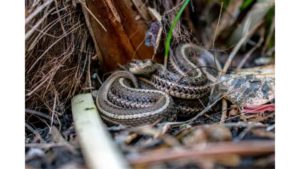Last Updated:June 19, 2025
9 Ways to Avoid a Snake Infestation on Your Patio or Yard

Snakes are typically found in the warmer climates of North America and Australia, but they can be brought into a cooler area with proper care. In order to avoid snake infestation on your patio or yard, it is important to understand what attracts them and how to keep them away.
In this post, we’ll cover 9 tips to keep snakes away from your patio or yard. As disclaimer, I am not an exterminator, but rather just a regular homeowner. My elderly mother called me after seeing a large 12″ brown snake crawling out from the corner of her patio.
After spending time to help her with it, I decided it would be a good topic for our site.
Seal any cracks or holes around your home
Any gap around your home that is larger than a 1/4 inch either needs to be fully sealed if possible or covered with a wire mesh when fully closing it off isn’t an option. This would be the case for drains or other water runoff spots.
Cracks will naturally develop overtime and we suggest looking for cracks around your home and foundation each spring. The freezing and thawing of the ground from the winter is a natural event that can lead to cracks so it’s best to catch them early.
If you live in a rural area, you may also want to check again in July. The reason is that during August snakes will start looking for places to settle down for the winter, and you’ll want to ensure that you properly seal the openings before a snake decides to make that their new home.
- Tomcat Rodent Block Expanding Foam Barrier fills gaps and cracks to block mice from coming inside your home
- Our spray foam is the pesticide-free way to create a rodent barrier
- This expanding foam provides a long-lasting, airtight, and water-resistant bond to most building materials
- Spray in crevices inside and outside your house, including the garage, attic, basement, and foundation
- Tomcat Rodent Block Expanding Foam Barrier can be trimmed, sanded, and painted if desired
Our favorite sealant is Tomcat Expanding Foam Barrier. We’ve used a lot of Tomcat products over the years, and I was happy when I found out they made sealant. While it says its designed to keep out mice, it will also keep out snakes. The fact that mice are also kept out is just a side benefit because keeping the mice away will also deter snakes since they won’t have their favorite little furry critter to eat.
The video below shows how to apply the foam sealant.
Trim your grass to keep away snakes
Snakes are cold-blooded creatures, so they prefer to live in a warm environment. They will often seek out anything that provides them with warmth and shelter, which is why snake infestations tend to happen right after people mow their lawns. Snakes can feel the vibrations from your lawnmower from under the ground and when you cut the grass it creates piles of fresh leaves for them to hide in. The snake may then stay on your property because there is plenty of food for them here. In order to keep snakes away, make sure you trim your grass regularly.
Tall grass provides many opportunities for them to hide from their predators such as hawks, cats or dogs. When grass gets dense or above ankle length, snake can freely slither through the yard without being detected. This just creates a safe haven for them.
Additionally, the tall grass becomes a paradise for insects and slugs which is a popular food for smaller snakes. By keeping your lawn maintained, you are also limiting the food sources of the snakes making it more appetizing for them to find a home outside of your yard.
Feed your pet inside
Many people keep their pet dish right outside their backdoor on the patio. This is one of the worst places for it when it comes to keeping snakes away. The dog or cat will naturally spill some of their food while eating, and any leftover food will just attract insects or mice. Both of which are delectable treats for the snake your trying to keep away.
Remove debris that can provide shade / shelter for the snake
Whether it’s a large plastic tote lid, some old plywood or a piece of metal siding, I’m sure everyone knows people who have excess debris in their hard. There’s nothing wrong with this, but it provides a king’s castle for a snake to hang out.
Snakes are cold blooded so when they need warmth, they can easily move on top of the board or lid. When they want to cool down, they just go under it. Depending on it’s weight, the snake’s predators may be unable to get to them when he’s under it meaning that it would always have a safe place to retreat to if it were attacked.
Additionally, it also creates a nice hiding spot for the snake to coil up ready to strike any suspecting prey that scurries by.
If you have a pile of rocks, ply wood or other types of large debris, I recommend storing them at the corner of your house as far away from your patio and home as possible.
It may not be possible for you to have no hiding spots in your yard, but if you do, you’ll want to keep those as far away from your home and pets as possible.
Forget about repellants
We’ve seen so many products on Amazon that promise to keep snakes away, and we’ve yet to find one that really seemed to make a difference. If you’re a company that owns a repellant, and you’d like to sponsor us to try it out please reach us via our contact form.
We’re happy to do a test of a product and report the results we have with it. If your product works, we’ll update this blog post, and include our results. If it doesn’t work, we’ll simply not include our results in the blog post.
We are not running detailed scientific tests, and I am not going to call out a product explicitly as being ineffective everywhere. This is not an assertion that I can make as a regular DIYer and homeowner.
Get rid of spiders, scorpions and other insects
The diet of many smaller snakes is primarily composed of spiders, scorpions and other insects. You can make your patio and home much less attractive to snakes by getting rid of their food sources. A yard with overgrown grass or an unkept garden will be a buffet to little snakes who just want to grab a quick bite.
The small snakes may decide your home is so inviting that they build their nest there and lay their eggs which is a very fast way to get a snake infestation.
Also, the small snakes will attract other predators such as bigger snakes, skunks and possums. These snakes can also get into fights with pets leading to expensive vet builds. This topic is big enough that we created a full guide to help you get rid of spiders and scorpions.
Don’t use a woven/cloth door mat
We’ve had multiple readers tell us that they’ve seen a snake lying under their doormat. Any sort of wrinkle or slight fold in the doormat will create enough space for the snake to slither and once underneath, it can just push further in.
This creates a nice form fitting hole for the snake, and as a homeowner you won’t even know it’s there until you step on the mat. Best case scenario, the snake is just started and darts out of the mat to run away.
In the less lucky scenarios, it could cause you to stumble and fall down. From there, the snake may see you as a threat and bite you before running away. From your perspective, you didn’t knot the snake was there and were just going out for a nice afternoon on your patio. However, from the snakes perspective, you were a predator that tried to crush it.
Instead of cloth or woven doormats, we recommend getting one that has a hard rubber bottom that will lie flat against the patio. The ensures that the snake won’t be able to slither under the mat to make a home fort itself.
Don’t use glue traps
I’ve seen a few places suggest using glue traps around the edge of your patio to keep pests away. I strongly advise against this. The glue traps are inhumane and will kill all types of natural wildlife. This not only includes the mice and snakes, but also small rabbits, some birds, or some small pets.
Even if you check the traps daily, anything caught it becomes a sitting duck for another predator. In essence, you’re just creating the perfect place for a snake to stay near as he’ll have a ready made dining table that will serve him a meal with little work.
If the glue trap does work, what is the plan? Are you going to led it starve to death? Are you going to leave it there and risk attracting a bigger snake to your property to eat the poor stuck smaller snake? How will you feel if a neighbor’s cat comes along eat the glue covered snake and then get sick from it.
A glue trap can seem like a good idea on the surface, but it’s really a terrible idea for snakes.
Contact an exterminator
Most counties will have animal control that will pick up a snake that is trapped in a container inside your home. However, unless it is securely inside a bucket or tote, they won’t chase it down for you.
If a snake is loose in your home or is in your yard, you are going to be better of calling a private extermination or pest control company. We called one out when we had a scorpion infestation, and they charged us $85 for the visit.
You should be able to discuss price and what services they will provide before agreeing for them to come out. Private exterminators will have professional catch and release traps that they can leave around your home. Once the snake gets in one of these traps, they will return to take both the snake and the trap away.
This may not be necessary if they can find it on your property while they are onsite. In many cases, people can relocate snakes with a single visit. There may even be snake rescues that are willing to relocate snakes for free in your region.
Get Rid of Standing Water
A bucket or other small container in your backyard that traps water is a godsend to a snake. They need to drink and any source makes it easier for them to make a permanent residence in your yard. If you have any extra flower pots, buckets, or watering cans outside, I recommend storing them in a tight sealed container. Either a shed or at minimum a sealed plastic tote.
If you store them with the opening facing up, they will capture water which the snake can use to stay there a lot longer. If you store them with the opening facing down, the snake can use it as a place for cover to get shade. Flower ports with a hole at the top and buckets with a pouring spout are especially popular for snakes as they have one easy way in and out.
Also, stop any drips from your hoses. This not only saves money on your water bill, but a dripping hose is a great way for snakes to get water especially on a patio. They can just curl up on the warm concrete next to the spigot and drink from the pool that collects there.
Wrapping up
Have you ever had a snake on your yard or patio? How did you deal with it? We love hearing from our readers with both their successes and their failures. You can reach us at our contact form or via our twitter account @newawning.






